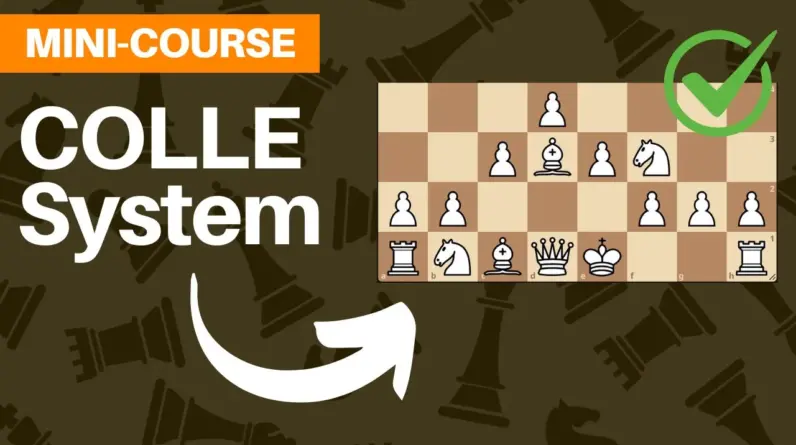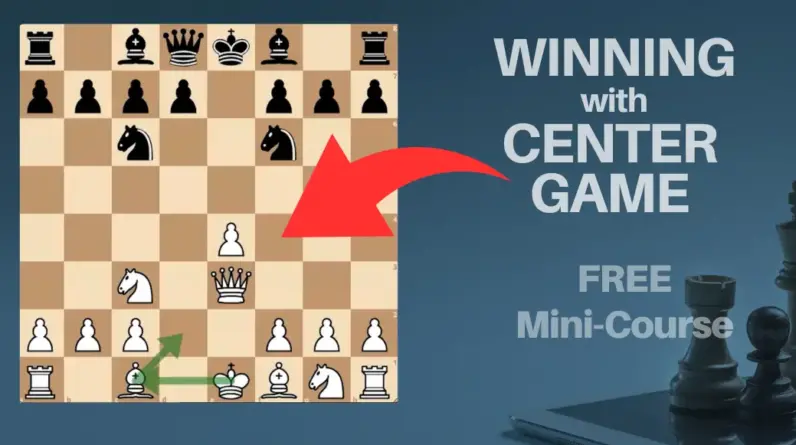You can choose a positional or tactical chess strategy to win in the middlegame. This choice depends upon your style of play.
Positional players are likely to play quieter lines when choosing a chess strategy to win their games. That’s not to say positional players shy away from tactics or are not good at them.
What if you could choose one chess strategy to win that worked in the opening, middlegame, and endgame? This strategy is one almost every chess player, regardless of playing style, will enjoy using – the initiative.
A large part of playing with the initiative is staying on the offensive. Sacrifices are an important part of many attacks, and intuitive sacrifices will often take your opponent by surprise.
Pattern Recognition Helps You Launch Attacks
When learning an opening, learn the tactics and typical attacking plans. For example, in an isolated queen’s pawn position, White can use a queen and bishop battery to attack h7.
A space advantage is nice to have while playing with the initiative. If you can advance your pawn to e5 when playing with white, it frees up enough space for you to consider an attack.
This attack can involve advancing the f-pawn, attacking with pieces and playing a sacrifice, or using both as part of your chess strategy to win.
Playing through master games will help you get a feel for the standard middlegame attacking plans and where to position your pieces in an opening.
Here is a game featuring the Advance Variation of the French Defense. Paulsen made excellent use of the space behind the advanced pawns to launch his attack.
Louis Paulsen – Adolf Schwarz, 1879.07.22, 1-0, Paulsen – Schwarz Round 3, Leipzig GER
One way to seize the initiative early in the game is to play the Keres Attack against the Sicilian Defense. The Keres Attack is characterized by an early g4 and attacking with a rook along the g-file.
Although Black has sufficient defensive resources, defending against an all-out attack aimed directly at your king is not easy. Even a player rated 2422 Elo could not hold out against White’s attack.
Hannes Stefansson (2525) – Throstur Thorhallsson (2422), 2022.04.30, 1-0, ch-ISL 2022 Round 8.5 Selfoss ISL
Playing with the initiative is a lot of fun, but don’t forget to pay attention to your opponent’s plans. These are not always easy to spot, and we sometimes forget our opponent is playing to win the game as well.
You Must Not Respond to Every Dangerous Threat!
When one of our pieces gets threatened, we instinctively look to move it away from the threat. This instinctive reaction is one we need to break.
Once again, the habit of looking for forcing moves can be helpful because it allows you to find a bigger threat. For example, if a pawn or minor piece attacks your rook, you can delay moving your piece by placing your opponent in check.
The one threat you cannot ignore is a threat to your king! Checks or checkmate threats need your immediate attention.
The most common response is to meet your opponent’s threat with one that threatens to win more material. However, you can threaten to create weaknesses in your opponent’s position and launch an attack.
This approach is handy if winning material draws defenders away from the king. When you have three more attackers than there are defenders, you can look to start an attack.
Take a look at this position from one of Tal’s games.
Tal is an exchange down, and his rook on b7 is threatened. Tal chose to ignore the threat to his rook, keep the initiative, and play 21.Bg5!!
Playing with the initiative is not only about a chess strategy to win; it improves your calculation skills and makes you a more courageous chess player. If Tal had miscalculated in this position, he could find himself playing with a bishop against two rooks.
This game was between Mikhail Tal and Efim Geller in the 1958 USSR Championship in Riga.
A Well-Planned Attack Helps Keep the Initiative
The best attacks are well-planned attacks that make use of standard motifs. Two of the most common motifs are a king that has not castled and a poorly placed piece.
Other common motifs include:
- Weak squares.
- Poor king position.
- Space advantage.
- Better piece coordination.
When attacking, it is often the pawns that lead the way. The pawns are also usually the first to get sacrificed to open lines against the king.
In this position, White uses the black bishop’s lack of mobility on g6 and the king in the center. Black is ready to castle, but Super GM Peter Svidler uses threats to the minor pieces to seize the initiative.
Svidler first attacked the bishop on g6 and then the knight on b6. He began with 1.f4 h6 2.f5 Bh7 3.c5 because capturing the pawn with 3…Bxc5 allows 4.Re1+.
The poorly placed bishop on h7 alone would provide excellent compensation for a pawn. Add the exposed position of the black king, and White has more than enough compensation for the sacrificed pawn.
Take a look at how Svidler finished off the game.
Peter Svidler – Alexey Dreev, 1997.05.19, 1-0, RUS-ch m1-2 Round 5, Elista
Your Chess Strategy to Win Needs Momentum
One of the reasons for ignoring your opponent’s threats is to retain the initiative. To keep the initiative, you need to keep the momentum on your side.
The initiative has clearly switched when you start responding to your opponent’s moves instead of keeping him reacting to yours. The last thing you want is for your opponent to use the initiative as their chess strategy to win.
You want to continually play forcing moves that keep the pressure on your opponent. These forcing moves can keep your opponent from taking advantage of a weakness in your position.
A weakness is only a weakness if your opponent can take advantage of it!
No matter how poor your pawn structure is, it doesn’t matter if you deliver a checkmate or if your opponent cannot attack your weak pawns.
Another way to keep the momentum on your side is to play unexpected moves. These moves do not need to be powerful moves posing dangerous threats.
All you need to do is cause your opponent to react and create a weakness in their position. For example, if there is a knight on g3, you could play …h5, which can cause your opponent to react to the threat of …h4 attacking the knight.
Continually evaluate the position on its merits and do not follow theory blindly.
Chess Opening theory might say both sides castle kingside, but if you can launch an attack with the h-pawn and castle queenside, do it and seize the initiative.
Sometimes your opponent will place their pieces in anticipation of you castling short. By castling long, you turn all these pieces into misplaced ones.
Efim Bogoljubov made this mistake against Alexander Alekhine in their 1929 World Championship Match.
Efim Bogoljubov – Alexander Alekhine, 1929.09.19, 0-1, Alekhine – Bogoljubov World Championship Match Round 8, Wiesbaden GER
In Conclusion
Because the initiative is not tangible, it is sometimes tricky for chess players to recognize it. The simplest way to determine if you have the initiative is to ask, “Am I reacting to my opponent’s moves, or is he reacting to mine?”
You do not need to launch an attack to gain the initiative. Forcing your opponents to position their pieces against a pawn break is playing with the initiative.
So long as your opponents are reacting to your moves, they cannot launch an attack against you. Playing with the initiative is a powerful chess strategy to win games from what appear to be quiet positions.
GM Ivan Sokolov knows the importance of initiative in chess. In his excellent Master Method course, GM Sokolov covers all the practical elements in chess that you must know to play with the initiative.
Attacking themes, sacrifices, rooks on the seventh rank, and more are all covered to help you improve your middlegame technique. GM Sokolov also offers practical advice on the openings and includes 10 essential endgames every chess player should know.
Ranked as high as number 12 in the world several times, Super GM Ivan Sokolov has the experience to ensure these 15 hours of practical chess training will raise your game.










